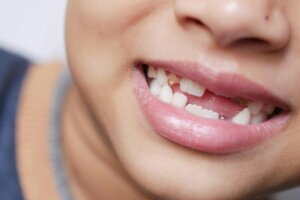Given that 36% of the population suffers from dental anxiety, imagine the scope of psychological challenges autistic people face in a dental chair! Bright lights and loud noises are stressful on their own, not to mention invasive procedures like tooth extraction or root canal treatment that require dental anesthesia. While dental visits may gradually become familiar, anesthesia usually causes various concerns. Let’s clarify the risks and benefits it poses for autistic patients.

Dental Anesthesia: Definition and Types
Anesthesia is an efficient pain management method in dentistry, aimed at causing a lack or loss of sensation in the treated area.
Dentists identify three types of anesthesia:
- Local anesthesia. Typically applied for less complicated procedures like filling cavities. Local anaesthetics take effect within 10 minutes and last up to an hour, leaving a patient conscious and able to communicate. The treated area will be numb and painless.
- Sedation. Used for pain control and relaxation in tablets, liquid medications, inhalations from a mask, injections, or intravenously. Conscious sedation enables a patient to follow commands, while semi-conscious sedation can cause amnesia.. In moderate or deep sedation, a dental team monitors a patient’s breathing, heart rate, and blood pressure.
- General anesthesia. Applied for lasting and more complicated procedures, such as wisdom tooth removal or dental implant placement. It is especially helpful when a patient suffers from overwhelming anxiety. A person under general anesthesia is completely unconscious, feels no pain, and has amnesia afterwards. Though riskier than local anesthesia and sedation, it is considered safe under an experienced doctor’s supervision.
The choice of anesthesia is affected by several factors, including the patient’s health condition and age, procedure duration, and adverse reactions to anesthetics in the past.
When Autistic Patients Need Dental Anesthesia?

People with autism might need dental anesthesia because of medical, mental, or psychological reasons. Sensory overload makes them less cooperative or capable of following the dentist’s instructions.
Conscious sedation is a proven behavior management tool when treating autistic kids, helping them handle occasional anger and temper tantrums. General anesthesia is commonly administered to certain patients who can’t tolerate dental treatment.
Benefits of Dental Anesthesia for People With Autism
The inability to tolerate physical stress and avoiding dental appointments can prove costly in the long run. Dental anesthesia provides a bunch of advantages:
- Enhanced Relaxation. Sedation dentistry helps ease all-encompassing anxiety or fear in patients with autism, promoting positive associations with dental procedures.
- Reduced Intensity of Sensory Inputs. Sedation and general anesthesia can dull sensory overload, providing a calmer patient’s experience. Patients can better tolerate the treatment when the dental environment is less overwhelming.
- Stronger Cooperation. Sedation helps autistic patients stay calm, cooperative, and stress-free, enabling a dentist to efficiently perform the treatment.
- Eliminated Need for Physical Restraints. Sedation dentistry offers a more respectful and compassionate approach than restraints, which can enhance anxiety in autistic patients.
- Fewer Dental Visits. Anesthesia enables comprehensive oral care as a doctor can complete several procedures in a single visit.
Patients with autism can significantly benefit from dental anesthesia and prevent more encompassing or severe conditions in the future.
Potential Risks and How to Alleviate Them
Local anesthesia is considered safe and doesn’t cause adverse reactions, while sedation and general anesthesia are associated with higher risks. Autistic patients need careful assessment of the type of anesthetics required. We’ve compiled a brief overview of risks that might accompany anesthesia use and possible solutions to minimize them.
| Risks | Description | Solution |
|
Autistic patients can be overly sensitive to particular drugs and experience negative reactions (itching, swelling, or hives). Rarely, a patient might encounter breathing problems and need emergency care. | Notify a dentist about any allergies a patient has. |
|
Individual reactions range from headache, nausea, and vomiting to numbness, dizziness, and hallucinations. | Tell your doctor about any drug-related side effects you had in the past. They will include this information in your dental treatment plan to prevent complications. |
|
If a person with autism takes anxiety medications or pain relievers, they might interfere with the effects of dental anesthesia. | Inform your doctor about medications you currently take. You might need to postpone them for 5 days before the dental procedure. |
Other risks, such as low blood pressure, seizures, coma, heart attack, and death, depend on individual peculiarities and team professionalism. Ensure you always address a reputed dental office with proven experts in the field of dentistry. To administer anesthesia to autistic patients, a dentist must closely cooperate with a dental assistant and an anesthesiologist. Knowledge of the concepts of dental anxiety will help professionals ease patients’ concerns and ensure a comfortable experience.
Dental Anesthesia: Optimal Conditions for Successful Treatment
Dental anesthesia success is impacted by various factors, including the medication, the anesthetized area, the doctor’s expertise, etc. Patients with autism require additional care based on their psychological needs and social support. Raise all your concerns and expectations with a dental team in advance, share your medical history, clarify special instructions, and ask questions. On the patient’s behalf, it is all you can do to mitigate risks for a successful outcome after dental anesthesia application.

Hi autismconnect.com Webmaster!
Greetings! Thank you for contacting Autism Connect. Please let us know how we can help.